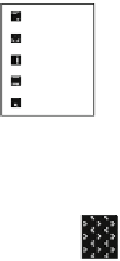Biology Reference
In-Depth Information
Control
Model
P
25
*
* *
P
20
II
*
*
P
III
15
*
10
5
*
*
0
GSH (mg/L)
T-AOC (U/ml)
MDA (nmol/ml)
1200
Control
Model
P
*
*
1000
P
II
PIII
800
600
* *
*
*
400
* *
*
200
0
GSH·Px (U)
SOD (U/ml)
Fig. 21.4
Effects of taurine on serum levels of GSH and MDA and activities of GSH.Px, SOD,
and T-AOC in rats. Results are presented as mean ± SE (
n
= 5). *: significantly different from the
model group (
p
< 0.05), **: significantly different from the model group (
p
< 0.01)
21.3.5
Taurine Reverses the Ultrastructural Injury
of Cardiomyocytes Caused by ISO
The ultrastructure of cardiomyocytes from the left ventricular at the level of the
apex image analysis is shown in Fig.
21.5
. In control group, myocardial tissue
showed a typical structure and slightly contracted myofibrils (Fig.
21.5
a, b). All
myofibrils and mitochondria were well arranged. The sarcolemma was attached to
the underlying myofibrils at each Z-line. The size of mitochondria was equal and
the cristae in mitochondria were tightly packed. The electron microscopy revealed
the ultrastructure changes that occurred in model group (Fig.
21.5
c, d): myofibrils
were disorderly with obvious fragmentation and dissolution, Z-line was curved,
and mitochondria were severely swollen with some cristae vanishing and disrup-
tion of mitochondrial membranes. Sarcolemma was ruptured accompanied by an
edema of sarcoplasm. The mitochondria were markedly aggregated near the
nucleus. The cardiomyocytes in group PI demonstrated less injury (Fig.
21.5e, f
).
Compared with model group, there was no evidence of myofibrils disruption and
interstitial edema, and mitochondria were slightly swollen with some cristae van-
ishing. The cardiomyocytes in group PII (Fig.
21.5g, h
) were similar to those






































































































Search WWH ::

Custom Search